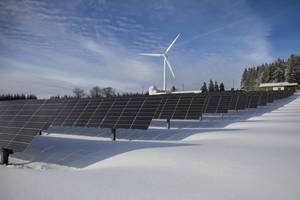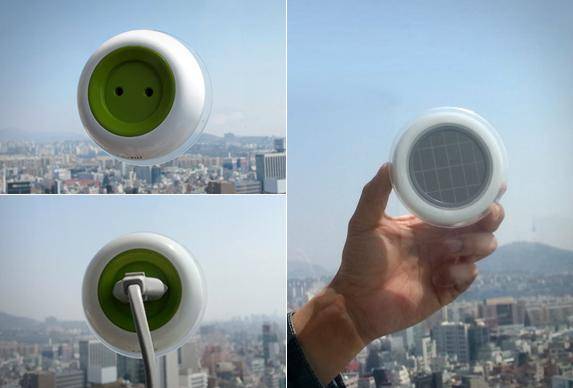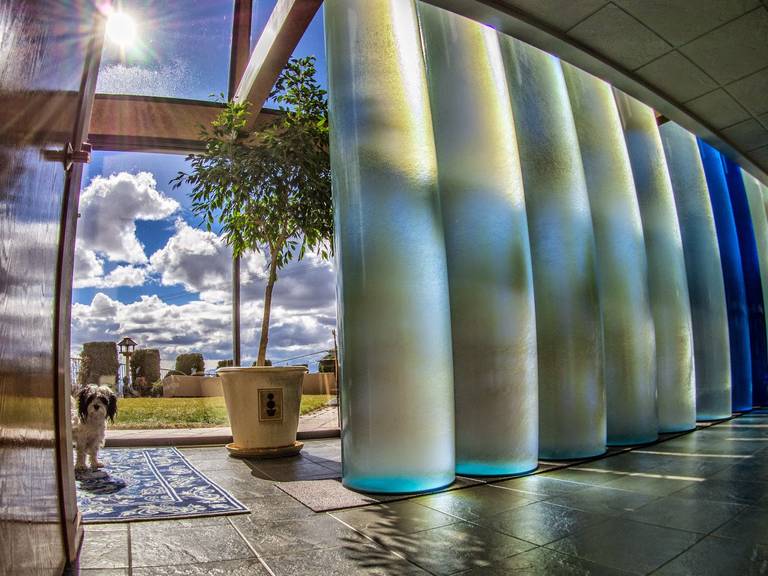Solar, Wind and Energy Efficiency Basics
Did you know that many off-grid homes are totally energy and water sufficient?
They are not connected to, or dependent upon utility power lines, city water supplies, and sewers.
The best part?
You can do that as well!
So here are a few essential facts and explanations to get you started with the renewable energy (solar and wind) and home energy efficiency:
Table of Contents
Energy Efficiency Basics
Before deciding which solar system to choose, there is one important thing you should pay attention to.
Here is the truth:
It is much cheaper to save energy than to produce energy.
So, if you want to offset $100 a month in utility bills, looking at your current home is the right place to start.
Read also: best solar design practices
Solar Hot Water Heating
The best return for your solar energy investment in most parts of the world is domestic solar water heating (DSWH).
A complete Domestic Solar Water Heating system can be installed for $500 to $5,000, depending on the climate, size, and complexity.
Solar hot water systems can be active or passive.
In warm climates, a simple passive system can provide plenty of hot water.
Solar Electric Systems - Photovoltaics (Solar Cells - Direct Solar Electricity)
Photovoltaic (PV) technology produces electricity from sunlight, using solid-state materials with no moving parts.
Photovoltaics, or "PV" for short, and more commonly known simply as "solar cells", are special semiconductor devices that convert sunlight directly into electricity.
The word photovoltaic derives from the words "photo" which means light (Greek for light is "phos"), and "volt", the fundamental unit of electrical energy potential.
Therefore, "photovoltaic" literally means "light-electricity".
Many individual solar cells can be packaged together into "PV modules" which can then be placed on a rooftop, carport roof, in stand alone arrays, and many other convenient places.
Here is a rooftop system in California, which is part of the Sacramento Utility District's program where homeowners volunteer to pay a small premium on the electric bill to host a PV system:
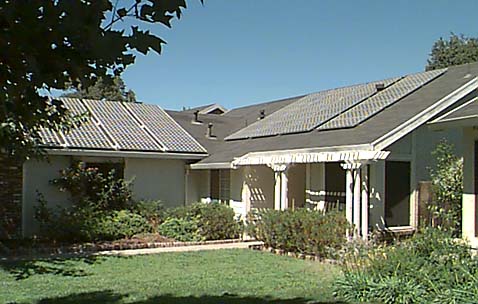
PV cells, as we know them now, were first developed in 1954 by Bell Telephone researchers and first applied to power satellites in space.
Photovoltaics System Components
The basic components of a complete home PV system are:
- PV panels: These produce the electricity from sunlight. There are typically 8 to 20 of these.
- Batteries: Used to store the energy. A typical (off-grid) installation uses 10-20 deep-cycle lead-acid batteries.
- Charge controller: To regulate battery charging. Charge controllers must also control the PV modules voltage, to operate them at their maximum power output (this is called "power point tracking").
- Inverter: Converts the low voltage DC (direct current) power from the batteries into 110 volt AC (alternating current) for use by home appliances.
The following diagram shows they are connected together:
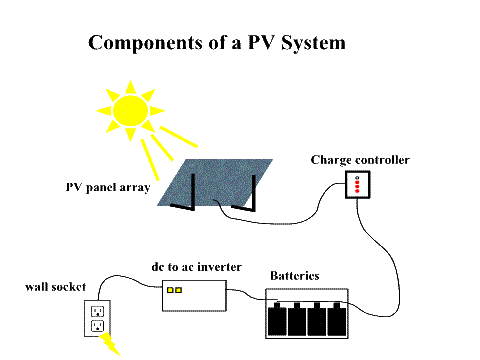
For residential applications, PV falls into two main categories:
- First is grid-tied, where the home generates its electricity and draws power from the utility company at night.
- The second is off-grid, where the home must generate its power, storing energy in batteries for use at night.
Learn how to calculate the size of a grid-tied photovoltaic system by assessing your use, roof, and yard.
Active Solar Air Heating - Active Solar Thermal
Although solar air and water heating systems gained a bad reputation in the 1980s, largely due to overly generous tax credits and the immature and sometimes disreputable industry that these credits created, these systems can function beautifully.
Especially in the sunny US southwest, and are still one of the most economical forms of solar energy if properly implemented. They can easily provide between 40% (Seattle) to 80% (Phoenix) of the hot water heating needs of a typical US family. Here is a photo of a solar hot water panel:
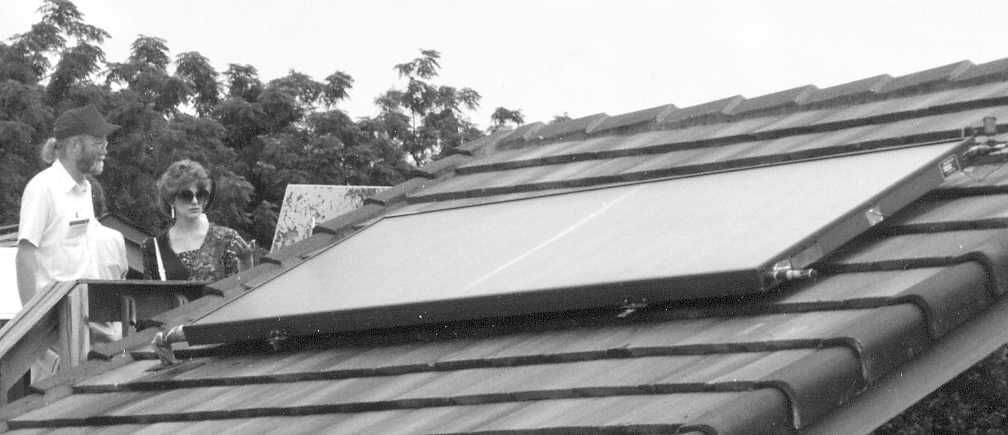
This type of collector is called a "flat-plate collector".
Active hot water systems themselves come in several basic types: one type uses antifreeze to keep the water in the collector from freezing on cold winter nights.
The other, so-called "drain-back" systems, let the water drain out of the collector at night, so that antifreeze is not needed. The latter can be an "open system", that is the water that flows through the collector can be used directly.
A disadvantage of active solar thermal systems is that they typically need more maintenance than passive systems, and have a higher upfront cost ($1000 to $4000 - passive systems are usually around $900).
One form of solar water heating that tends to require less maintenance and upfront cost, and which might be characterized as the passive form of active solar thermal is called batch solar water heating. In this approach, the collecting surface is the darkly covered surface of a water tank itself.
The tank is usually insulated and covered with glass, just as is the case with a flat plate collector. Pumps are not generally necessary in this kind of system. Instead, the tank-collector is simply used to pre-heat the water before it goes into a supplemental hot water heater. That way, if the sun has heated the water, the hot water heater need not. Otherwise, the hot water heater kicks in.
Another variation on this approach is to have a hot water tank located at the top of, or underneath a flat plate collector. In this approach, cold water naturally flows downwards into the collector, and hot water flows back upwards into the tank, in a convection driven process called thermosiphon. These systems are called "integral" systems.
Batch systems may be conveniently located underneath skylights or clerestories, with or without insulation on the sides and back sides, giving great flexibility to how they are integrated into a home.
Finally, some hot water systems are integrated directly into sunspace or clerestories, as hot water pipes running just underneath the glazing and attached to metallic collectors.
A more DIY approach, solar air heaters, while not commonplace, are a tried and true technology. A kit costs around $1,500, or make one yourself by getting the materials at a local hardware store.
How Solar Air System Works
Solar air heating system can be installed on a solar suited home in approximately 4-6 hours by a two-person crew and is maintenance-free. The basic twin solar collector system is all you need to provide solar heat for an approximately 1200 sq. ft home.
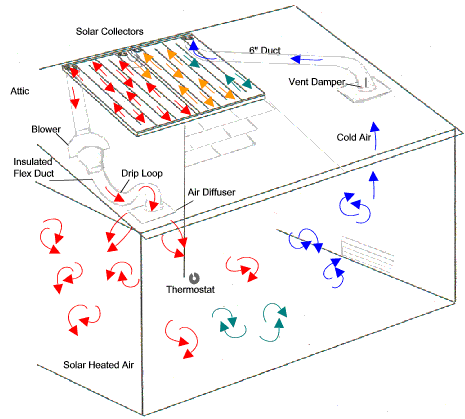
Cold air is drawn from the home through a grill located in a room below the collectors using a 6" triple insulated flexible duct. The blower pulls the air through the collectors, and the solar-heated air is forced through a duct to target areas; main floor, upper levels, or both. The solar air heating system can be tied into the forced air furnace return line.
Passive Solar Building Design
Design with natural energy flows to improve home efficiency.
Perhaps the most cost-effective and sensible form of solar energy, passive solar design, is the idea of designing buildings to take advantage of the natural sunlight for heating in the wintertime, and to properly block sunlight for cooling in the summer.
Basic passive solar heating (and cooling) is mostly free if implemented during design. The enhanced passive solar systems usually pay for themselves in several years.
The main principles of passive solar design are:
- Solar Gain: Getting enough sunlight in at the right time (and as well blocking it when not needed).
- Thermal Mass: Having enough thick masonry surfaces to store the energy from sunlight to keep the home from overheating during the day and warm at night.
- Insulation: Having good insulation (with low air leakage) to keep the heat out during the summer, and heat in during the winter.
| Solar Passive Design Principles | Summer | Winter |
| 1. Use thermal mass | Absorbs energy during the day for coolness | Releases absorbed energy for warmth at night |
| 2. Smart solar gain | Take advantage of the Sun's seasonal path to block the sun | Take advantage of the Sun’s seasonal path to let the sun in |
| 3. Good insulation | Keeps the heat out | Keeps the heat in |
The key to getting solar gain at the right time (winter), and not at the wrong time (summer) is to take advantage of the fact that the path taken by the winter sun is much lower in the southern sky than the path taken by the summer sun (which passes nearly overhead at high noon:
The way to take advantage of these differing paths is to place most of the windows on the south side of the home and add overhangs over these south-facing windows for additional summer shade.
Both of these homes have rainwater harvesting, cisterns, Trombe walls (a masonry wall with glazing that stores solar energy for night time use), direct gain (many southern windows), and passive "batch" solar hot water.
Passive Solar Design History
Passive solar design has a fascinating history, stretching at least back to the Greeks, who planned entire cities to take advantage of the Sun's energy. A great book on the history of solar energy is "A Golden Thread - 2500 years of solar architecture and technology", by Ken Butti and John Perlin, Cheshire Books, CA, ISBN 0 917352 08 4.
Native American tribes of the southwest, as well, have long applied these techniques. Their cliff dwellings, for example, those at Mesa Verde, faced south, so that they take advantage of the low winter sun during winter, but were shaded by the overhanging rock during summer.
Likewise, the thick rock and adobe walls of these dwellings served as thermal mass to store the Sun's energy and keep the buildings warm at night.
Right Placement and Sizing of Windows
Windows on the non-south sides should be sharply limited in their surface area to prevent heat loss. Windows on the south side, on the other hand, should have quite large surface area, but not too large.
Recommended Net Glazing (Window) Areas for northern New Mexico:
| Orientation | Percent of total floor area |
| East | 4 |
| North | 4 |
| West | 2 |
| South | 7-12 (depending on whether additional thermal mass is present) |
Right-Sizing of Overhangs
Overhangs are strongly encouraged for south-facing windows and Trombe walls in Northern New Mexico. The following overhang angles are not the angles one would get from most books corresponding to the winter and summer solstices.
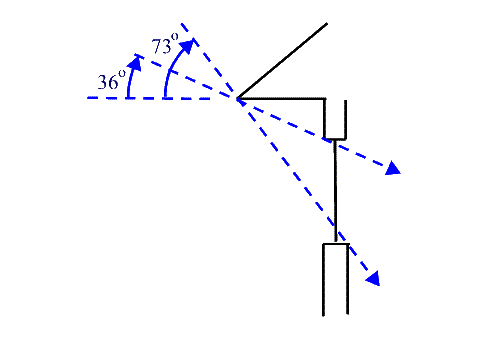
Rather, they have been adjusted by five degrees or so for the climate of New Mexico, such that they provide eight weeks of full solar gain on either side of the winter solstice (as opposed to just on the winter solstice), and a full eight weeks of shade on either side of the summer solstice (as opposed to just on the summer solstice).
Right Surface Area and Thickness of Thermal Mass
The usual sheet-rock, studs, furniture, etc of a house represent a certain baseline amount of thermal mass:
Without additional thermal mass, direct gain (south-facing windows) should not exceed 7% of floor area.
A house that has 7% direct gain is sometimes called a "sun-tempered" house.
Even if adequate additional thermal mass is added to the house, for example, by adding internal masonry walls or floors with masonry thicker than an inch, then direct gain (south-facing windows) can be up to but should not exceed 12% of the total floor area unless you are careful to avoid, or live with, a large degree of glare.
If adequate additional thermal mass is added to the house, an additional indirect gain (e.g., Trombe walls) may also be added to with a glazing area up 8% of the total floor area in addition to the 12% direct gain without overheating the house during the day.
Total solar gain area for a house with added thermal mass can therefore be up to but should never be more than 20% of total floor area.
The simplest rule of thumb is that thermal mass area should have at least 6 times the (uncovered) surface area of the direct gain glass area. More detailed mass sizing info is contained in the guidelines.
Thermal mass effectiveness increases proportionally to thickness up to about 4 inches. After that, effectiveness doesn't increase as significantly. So concentrate on getting the surface area and the first four inches of thickness, and not on excessive thickness and volume.
Contrary to common belief, it is not important to have all the mass in the direct gain path - so don't worry about trying to arrange for this! Rather, strive to have thermal mass in line of sight of sunlit surfaces.
Right Arrangement of Thermal Mass
Once light enters through the windows, reflection and thermal re-radiation can transmit energy from the sunlit surfaces to other thermal mass surfaces which are in line of sight of the sunlit surfaces.
Non-sunlit floor area, for example, will not function well as thermal mass with respect to sunlit floor area because it is not in line of sight with sunlit floor areas.
Contrary to common belief, it is not advisable to color all thermal mass surfaces darkly (with the exception of indirect gain surfaces such as Trombe walls and water walls, which need to be very dark).
Walls lit by clerestories, for example, are better painted white, such that they reflect the light to other thermal mass surfaces, such as the floor. If the wall becomes too hot, a thermal-siphon airflow can be set up that effectively heats the air and overheating the space.
In general, wall and ceiling thermal mass surfaces should be light-colored, while floors should be dark. Making the floor dark helps keep the floor warm and easier to clean, in addition to providing good adsorption of thermal radiation.
Right Arrangement of Rooms
Room layout should take advantage of morning sunlight for the kitchen, and possibly a bedroom, winter sunlight for the living room, and make use of buffer spaces and garages as additional northern and western shielding, as the following diagram suggests:
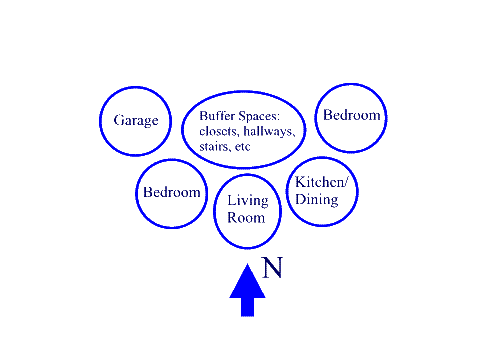
A sunspace might be added with advantage in front of the living room.
Ground Source Heat and Cooling Basics
Ground-source heat pump (GSHP) heating and cooling, often called a geo-exchange or geothermal system, is an efficient way to keep a house comfortable.
A GSHP system can save at least 50% on a typical home heating bill.
Wind System Basics
Wind turbines use technology that converts the moving wind kinetic energy to useful electricity.
Wind power is collected and converted by the rotor, so the turbine's most important characteristic is its rotor size.
Working with an Installer
Solar energy technologies are simple, but installing an array can be a complex job, especially when the roof is sloped and very high.
It consists of technical expertise and the ability to navigate the thicket of permits and incentives to get your project approved and financed.
Of course, you can also install solar system by yourself if you have some prior DIY experience, handyman skills and the right tools...

